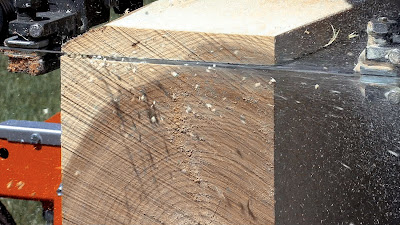By Arnold M. Sewell
LT40 Hydraulic Owner
Timberline Farm Sawmill
Sykesville, MD
LT40 Hydraulic Owner
Timberline Farm Sawmill
Sykesville, MD
For forty-five years, my own business I had.
I’d started it young; I was just a lad.
Pianos I could fix, any shape or size,
But, it’s time to retire, I began to surmise.
So one day in the woods, I was cutting a tree,
I’ll make some boards, did occur to me.
I’d started it young; I was just a lad.
Pianos I could fix, any shape or size,
But, it’s time to retire, I began to surmise.
So one day in the woods, I was cutting a tree,
I’ll make some boards, did occur to me.
With chainsaw in hand, and all of my strength,
I made some boards, of very short length.
I like this I thought, this is what I’ll do,
But a good saw I’d need, very straight and true.
So I read and talked, and found an advisor,
And soon ordered my saw, a brand new Wood-Mizer.
An “LT15” is what I got,
I sawed every day; I used it a lot.
But in a short time, my interest grew,
A bigger saw I’d need, yes this I knew.
So I sold my first mill, and bought a new one,
“LT40” Hydraulic, now I’ll get some work done!
I made some boards, of very short length.
I like this I thought, this is what I’ll do,
But a good saw I’d need, very straight and true.
So I read and talked, and found an advisor,
And soon ordered my saw, a brand new Wood-Mizer.
An “LT15” is what I got,
I sawed every day; I used it a lot.
But in a short time, my interest grew,
A bigger saw I’d need, yes this I knew.
So I sold my first mill, and bought a new one,
“LT40” Hydraulic, now I’ll get some work done!
The logs came in, and so did the trade,
And soon I realized, a new business I’d made.
I work mostly alone, but more help did I need,
There must be a machine, to increase my speed.
So with some thoughts, and a look at my ledger,
I decided to buy, a “Twin Blade Edger”.
Wood-Mizer did have, the perfect machine,
And soon it arrived, all new and pristine.
Now quick and away, the flitches they flew,
Time and waste was reduced, and my troubles were few.
And soon I realized, a new business I’d made.
I work mostly alone, but more help did I need,
There must be a machine, to increase my speed.
So with some thoughts, and a look at my ledger,
I decided to buy, a “Twin Blade Edger”.
Wood-Mizer did have, the perfect machine,
And soon it arrived, all new and pristine.
Now quick and away, the flitches they flew,
Time and waste was reduced, and my troubles were few.
I work every day, but at my retired pace,
I refuse to re-enter, the world’s rat race.
A lot of my customers, are retired too,
Making things out of wood, is what they do.
Both men and women, of all levels come in,
It’s easy with lumber, their interest to win.
I refuse to re-enter, the world’s rat race.
A lot of my customers, are retired too,
Making things out of wood, is what they do.
Both men and women, of all levels come in,
It’s easy with lumber, their interest to win.
It’s been eight years, many thousands of board feet,
I’ve cut with my mill, and it still runs sweet.
Oh, once in a while, I’ll need a small part,
Or send in my blades, to have them made sharp.
And if I need help, from “Customer Support”,
They’ve got the answers I need, and things of that sort.
I’ve cut with my mill, and it still runs sweet.
Oh, once in a while, I’ll need a small part,
Or send in my blades, to have them made sharp.
And if I need help, from “Customer Support”,
They’ve got the answers I need, and things of that sort.
So on and on, I’ll go with my mill,
The days of my life, it surly will fill.
The logs come in, and the lumber goes out,
My retirement is great; there is no doubt.
So this is my story, of recent years,
To those of you, with listening ears.
And if you want to, and have the desire,
This may be the way, you ought to retire!
The days of my life, it surly will fill.
The logs come in, and the lumber goes out,
My retirement is great; there is no doubt.
So this is my story, of recent years,
To those of you, with listening ears.
And if you want to, and have the desire,
This may be the way, you ought to retire!

























.jpg)
.jpg)
.JPG)















